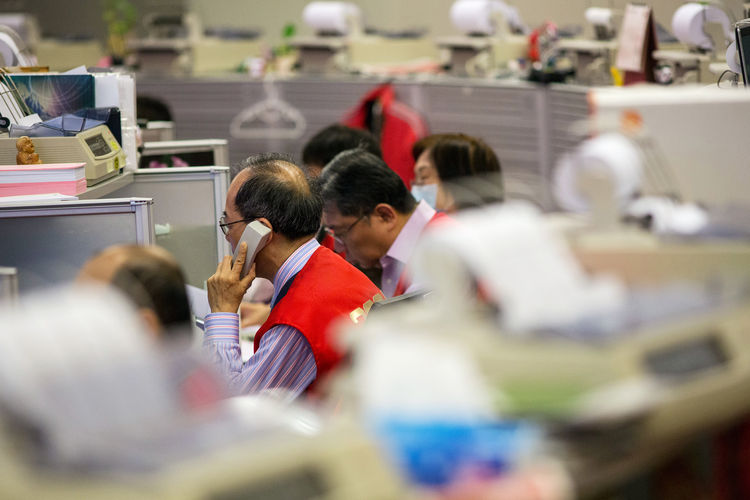The second day of Jerome Powell’s semi-annual testimony on Capitol Hill passed without incident, in contrast with the frenzy on Wednesday. He reiterated an unconditional commitment to fight inflation by the Federal Reserve, but markets instead, continued to price in a recession stopping rate hikes in their tracks much sooner. US yields fell once again, equities firmed once again, cryptos crept higher, while currency markets did almost nothing unless we are talking about USD/JPY.
Assuming that the Fed will have to change course sooner than late 2023 isn’t an unreasonable assumption. The Fed and a procession of central banks around the world got inflation completely wrong and have been scrambling to reverse the mistake. Given their track record, assuming they are going to be wrong the other way is completely reasonable in that context.
The commodity space is also pricing in the recession outcome. Copper prices plummeted overnight, and that has been the case recently with most industrial metals. Even soft commodity prices have fallen, and I’ve even seen a few headlines here in Indonesia about small palm oil farmers’ incomes taking a hit. Oil has taken a bath this week as well, and the increase in natural gas inventories overnight from the EIA data saw US natural gas prices fall as well.
Still, I remain unconvinced that inflation will magically just stop in its tracks just because Mr Powell mentioned the word recession. Oil futures curves on both Brent crude and WTI remain in backwardation, which tells us prompt supplies are tight. The curves moved down in totality but didn’t really change shape. We are getting plenty of headlines from around the world about potential blackouts as energy supplies and power generation capacity remain under stress. Russian oil and gas production will decrease as well as they run out of western parts to maintain production. Most significantly, Germany activated phase two of its emergency energy plan overnight, as Russian gas flows continued slowing. If Europe is heading to international markets at short notice to hunt for supplies, energy prices aren’t going to fall much further.
The moves this week, could still turn out to be the result of a financial market genetically pre-programmed to buy dips in equity and bond prices, thanks to two decades of central bank largesse. It could also be a bear market correction as the stampede for the exit door got overdone in the short term, leading to a short-squeeze. Maybe next week’s PMIs will give markets a better clue, or perhaps the July Non-Farm Payrolls and JOLTS data. It would be foolish to price out geopolitical stresses related to Ukraine/Russia conflict either, particularly in relation to European energy or Ukrainian food exports. The FOMC meeting on the 26-27th of July may as well be next year at present, we can expect a lot more volatility between now and then.
Yesterday, the central banks of Indonesia and the Philippines sprung no surprises. BI kept policy rates unchanged thanks to a benign inflation landscape for now. BSP hiked by 0.25% as expected. The Indonesian Rupiah eased overnight, but overall volatility in the Asian FX space was flatlined.
Today has a Friday feel to it with an extremely light data calendar in Asia. Japan Inflation is already out, with the headline for May unchanged at 2.50%, and core unchanged at 2.1% YoY. That is the second month above the BOJ’s 2.0 target for headline inflation. But before we all get excited, that’s two months after trying to achieve it for over 20 years. Nobody should expect it to prompt a sudden change of direction in monetary policy, especially as much of the increase is due to higher imported PPI inflation, and a weaker yen.
Malaysian Inflation is expected to remain benign at 2.60% YoY, while Singapore Industrial Production should remain steady at 6.0% YoY. Neither will move the needle in volatility terms today in Asia. China’s Final Current Account for Q1 this afternoon is already old news. This afternoon’s UK Retail Sales and German IFO Business Climate survey both have downside risks. And given the escalation of the energy situation in Germany, both Euro and Sterling could go into the weekend looking shaky once again. US New Home Sales and Michigan Consumer Sentiment also have downside risks. Weaker than expected numbers do not provide a fertile ground for stock market exuberance, lower interest rates or not. If the data is disappointing, US equities could unwind some of this week’s gains.
Asian equities are content to follow Wall Street’s rally.
Wall Street booked another session of decent overnight gains as somewhat counteractively, lower US yields on recession fears, prompted more equity buying. The S&P 500 rose by 0.95%, the Nasdaq jumped 1.62% higher, while the Dow Jones gained 0.66%. The rally continues unabated in Asia, with US futures booking more gains in Asia, suggesting the overnight rally in the OTC markets still has legs. S&P 500 futures are 0.50% higher, the Nasdaq is loving lower US yields and Nasdaq futures are 1.0% higher in Asia. Dow futures have added a respectable 0.30%.
Asian markets are content to follow the leader, with the overnight rally on Wall Street lifting Asian markets higher into the end of the week. Japan’s Nikkei 225 is 0.95% higher, while South Korea’s Kospi has leapt 1.70% higher thanks to Nasdaq’s outperformance.
In Mainland China, the Shanghai Composite has climbed by 0.45%, with the CSI 300 gaining 0.55%. Hong Kong’s Hang Seng has jumped by 1.50%. In regional markets, Singapore is 0.35% higher, with Taipei rising by 0.85%. Kuala Lumpur has gained 0.45%, Jakarta 0.80%, Bangkok 0.55%, and Manila 1.30% after a dovish rate hike yesterday. Australian markets are showing no ill effects from the resource price retreat. The All Ordinaries has risen by 0.55%, and the ASX 200 by 0.35%.
European markets took fright at the German activation of its phase two emergency energy plan and reducing Russian gas flows is bad news for Europe as a whole. As a result of this, it is unlikely that European markets will find any reason for cheer into the weekend.
Currency markets continue their sideways trading.
Currency markets remained steady once again overnight and seem to be finding the back-and-forth histrionics in the stock and bond markets a bit tiresome. Currency markets seem to be adopting a step out of the noise, wait-and-see approach into the end of the week. Thanks to a rise by the Yen, and a fall by the Euro cancelling each other out, the dollar index remains almost unchanged on a 24-hour basis at 104.29 today. The dollar index has support at 1.0350 with resistance now distant at 1.0570.
EUR/USD fell by 0.45% to 1.0520, creeping up to 1.0530 in slow Asian trading. It is showing surprising resilience as the Russian natural gas exports to Europe situation deteriorates. Because of this, risks have shifted to the downside for the single currency. It has initial resistance at 1.0600, with challenging resistance at 1.0650. Support is at 1.0450 and 1.0400. Sterling probed the 1.2200 downside once again overnight but is almost unchanged over the past 48 hours at 1.2275 in Asia. GBP/USD has initial resistance at 1.2360 and 1.2400, with support at 1.2200, 1.2160, and then 1.1950.
USD/JPY mechanically fell by 0.93% to 134.95 overnight in lockstep with lower US yields. In Asia, it has eased to 134.70. If bond yields ease again tonight, a deeper correction by USD/JPY is possible, potentially targeting the 132.00 regions. USD/JPY has support at 134.25 and 132.00, with resistance at 136.65 and 138.00.
AUD/USD and NZD/USD were mostly unmoved overnight. Overnight, AUD/USD has eased by around 0.40% overnight to 0.6900, while NZD/USD is unmoved at 0.6295 thanks to a local holiday. Both are finishing the week near their lows and risk more losses in New York time if sentiment remains negative. Support is at 0.6850 and 0.6200 respectively.
Asian currencies finished almost unchanged overnight, but with USD/Asia remaining near to recent highs. That reflects fears that a US recession will have an immediate knock-on impact on Asian growth and notably, lower US yields and a stock market recovery this week have given no support to local currencies. Looking at the price action overnight and today, I wouldn’t be at all surprised if quite a few of the region’s central banks are quietly on the offer, capping the USD/Asia upside.
Oil prices are noisy but unchanged.
Oil prices had another noisy overnight session, trading in wide intraday ranges. Ultimately, as the dust settled, both Brent and WTI finished almost unchanged for the second day in a row. The unexpected postponement of the official US Crude Inventory data set due to technical issues likely played a major role in the neutral close, as the data set is one of the most closely monitored in the global energy sphere.
Brent crude fell 0.30% to $109.65 overnight, gaining 0.40% to $110.10 a barrel in Asia. WTI fell 0.45% to $103.95 overnight, before rising 0.55% to 4104.55 a barrel in Asia. The net result is that oil prices are almost unchanged on a 24-hour basis.
Looking at the respective futures curves, both Brent and WTI are still heavily in backwardation, suggesting that prompt oil supplies remain as tight as ever, even as prices across the curves fall. Increasing recession fears appear to be prompting a culling of heavy speculative long positioning in both contracts, even as in the real world, energy tightness is as real as ever.
The technical picture is interesting. Brent crude has tested its 100-day moving average, and the 2022 support line at $107.30, but managed to bounce back to $110.00 a barrel. A daily close under $107.30 implies a deeper move potentially reaching $100.00 initially.
WTI’s technical picture is much softer, having closed below its 2022 support line at $106.30, and its 100-DMA, today at $105.50 a barrel. Failure of its weekly low at $101.50 could trigger a capitulation by speculative longs that moves WTI under $100.00 a barrel, although I suspect a lot of the damage has already been done.
Gold falls overnight.
Gold bugs once again appear to have lost patience, as gold fell by 0.82% to $1822.50 overnight, edging slightly higher to $1824.00 an ounce in Asia. Probably most concerning, was that gold fell as the US Dollar remained mostly unchanged and US yields had another big move lower. Even cryptos managed to move slightly higher overnight. With that in mind, it appears that gold is going into the end of the week looking vulnerable, although I am not betting against the $1800.00 to $1870.00 range trade continuing.
Gold has resistance at $1860.00 and $1880.00, the latter appearing an insurmountable obstacle for now. Support is at $1805.00 and then $1780.00 an ounce. Failure of the latter sets in motion a much deeper correction, potentially reaching $1700.00 an ounce. On the topside, I would need to see a couple of daily closes above $1900.00 to get excited about a reinvigorated rally.





























